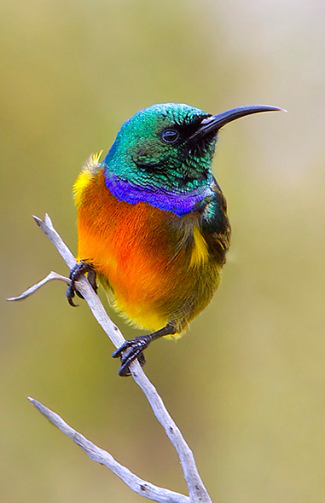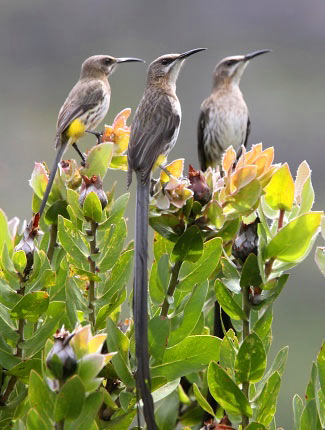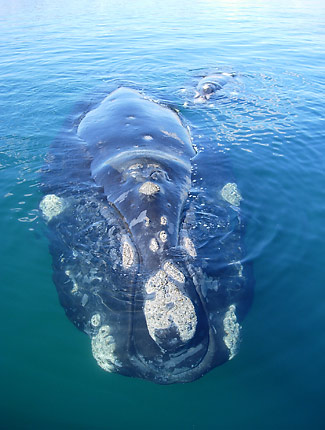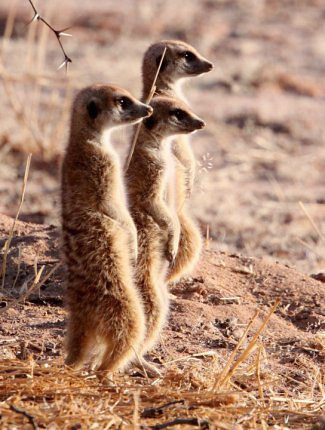

The beautiful Orange-breasted Sunbird by Dubi Shapiro.
- Southern Right Whale, viewable from shore and boats
- About 27 out of 38 birds endemic to South Africa, Lesotho and Eswatini including Cape Rockjumper, Cape Sugarbird and Orange-breasted Sunbird
- Other specialities including some of the 140-150 species endemic to Southern Africa such as African Penguin, Black Harrier, Blue Crane, Karoo and Ludwig's Bustards, African Oystercatcher, Hartlaub's Gull and Cinnamon-breasted Warbler
- More widespread spectacular birds such as Common Ostrich, Pygmy Falcon and, possibly, Hamerkop, African Fish-eagle, Secretary Bird and Kori Bustard
- A wide variety of seabirds including albatrosses
- And the greatest diversity of larks in the world
- As well as mammals which include Meerkat, Gemsbok and Bontebok, and, possibly, Aardvark, Aardwolf, Crested Porcupine and Black-footed Cat on night drives in private reserves
- Although classic African mammals such as Lion, Leopard, Cheetah and Spotted Hyaena are a long way off the beaten track
- All in some superb settings which include the Fynbos, the richest flora in the world
- In 1975 one of the greatest films ever was released. Jaws scared virtually everybody who saw it and everybody who heard about it, and became the highest-grossing film, proving once again that people like being scared. Shark hunter Quint, played by Robert Shaw, takes out the local police chief and an oceanographer in his old boat Orca to kill the star of the film, the Great White Shark, the imminent arrival of which is accompanied by John Williams’s ominous 'dur-dum, dur-dum, dur-dum'. While they wait on the bobbing boat Quint says, ‘The thing about a shark, it’s got lifeless eyes, black eyes, like a doll’s eyes. When it comes at you it doesn’t seem to be livin’... until he bites you, and those black eyes roll over white.’ In South Africa, out of Gansbaai/Kleinbaai not far from Cape Town, it used to be possible to see those eyes, and the famous jaws, from a boat ... or... a cage ... even a cage held just below the surface, in which it was possible to stand, in a wetsuit but without the need for scuba-diving equipment, then duck underwater to see the ultimate predator face-to-face!
- However, there were only a few Great White Sharks in 2019 and 2020. In 2016 85,000 people cage-dived off the coast, with an average of 20 or more sharks circling the boats in the Gaansbaai/Kleinbaai area. In 2019 the average was about five. In False Bay, about a hundred miles to the west, after 200 sightings in 2016 and 50 in 2018 they had disappeared altogether by 2019. The reasons for the sharp decline may include over-fishing, changes in sea temperatures and long-range distributional changes but one of the main ones, at least in False Bay, appears to be the arrival of two Killer Whales in 2015, after which several Great Whites washed up with signs of being killed by the whales; the Killers grab the shark's pectoral fins, flip them over, rip them open and eat their livers, leaving the rest to rot or wash up. Taking the Great White's place in False Bay is the Sevengill Shark, an aggressive scavenger, which, although it can reach a maximum length of three metres (9.8 ft), unfortunately lacks the allure of the Great White.
- One of the best places in the world to see whales without boarding a boat is from the scenic cliff-top walk by the seaside resort of Hermanus, especially during September and October when as many as a hundred Southern Right Whales may be present, having migrated from the Southern Ocean and Antarctica to visit the inshore waters to mate, calve and suckle their young. Views are better from boats of course and most operators offer three trips a day lasting up to three hours. The peak months are usually September and October, and the annual Two Oceans Hermanus Whale Festival usually takes place in September.
- It is not possible to cover every site in Western South Africa during a couple of weeks, especially if the itinerary includes Kgalagadi Transfrontier Park, the only place Lion (black-maned), Leopard, Cheetah and Spotted Hyaena, as well as birds such as Lilac-breasted Roller, Crimson-breasted Gonolek and Groundscraper Thrush are likely to be seen, and there is a chance of Brown Hyaena and Honey Badger, so it may be worth considering at least two visits to this part of the world. On the other hand, visitors with plenty of time may even wish to consider extending their trip to Eastern South Africa where it is possible to see most of the classic African mammals including African Elephant, Giraffe, Hippopotamus, and White and Black Rhinoceroses, birds such as Saddle-billed Stork and Wattled Crane, another of the best wild flower displays in the world and, along the coast and offshore, turtles, Whale Shark and the Sardine Run. Some tour companies even combine the best of Western and Eastern South Africa in single tours.
- Many of Western (and Eastern) South Africa's National Parks, and Private 'Game Parks and Reserves' are surrounded by high fences and, to a varying extent, 'stocked' with reintroduced 'wild animals', bred in captivity, for people to see or people to shoot. The numbers of each 'wild animal' may also be very carefully 'controlled'. Some people think this is the right way to go about things and argue that the money from tourism funds the conservation of the 'wild animals', some think there has to be a better way.
Best Birds and other wildlife in Western South Africa
Birds
South Africa Endemics 16 out of 18
Southern Black Bustard, Hottentot Buttonquail, Forest Buzzard, Knysna Woodpecker, Cape Parrot, Cape Rockjumper, Agulhas Long-billed Lark, Karoo Lark, Red
Lark, Victorin’s Warbler, Knysna Warbler, Cape Bulbul, Cape Sugarbird, Orange-breasted Sunbird, Protea Canary and Cape Siskin.
South Africa, Lesotho and Eswatini (formerly Swaziland) Endemics 11 out of 20 Grey-winged Francolin, Knysna Turaco (not Lesotho), Ground Woodpecker, Southern Crested-flycatcher (not Lesotho), African Pied Starling, Chorister Robin-chat, Sentinel Rock-thrush, Cape Rock-thrush, Greater Double-collared Sunbird, Yellow-tufted Pipit and Forest Canary.
Near-endemics
South Africa and Namibia 25 (A crane, a penguin and seven larks) Blue Crane, Karoo Bustard, African (Jackass) Penguin, Crowned Cormorant, Bank Cormorant, Hartlaub’s Gull, Black Harrier, Jackal Buzzard, Grey Lark, Karoo Long-billed Lark, Cape Long-billed Lark, Barlow’s (Dune) Lark, Cape Clapper Lark, Sclater’s Lark, Large-billed Lark, Karoo (Yellow-rumped) Eremomela, Namaqua Warbler, Cinnamon-breasted (Kopje) Warbler, Karoo Prinia, Layard’s Warbler, Orange River White-eye, Karoo Scrub-robin, Southern Double-collared Sunbird, Cape Weaver and Black-headed Canary.
South Africa, Namibia and Botswana 7 Northern Black (White-quilled) Bustard (also in Lesotho), White-backed Mousebird, Fairy Flycatcher, Black-eared Sparrow-lark, Rufous-eared Warbler, Karoo Thrush and Sociable Weaver.
South Africa, Namibia and Angola 7 African Oystercatcher, Rosy-faced Lovebird, Grey-backed (Red-headed) Cisticola, Pale-winged Starling, Sickle-winged Chat, Mountain Wheatear and White-throated Canary.
South Africa, Namibia, Angola and Botswana 6 Ludwig's Bustard, Burchell’s Courser, Short-toed Rock-thrush, Karoo Chat, Tractrac Chat and Stark’s Lark.
Other specialities (including some of the 150 or so species endemic to Southern Africa)
Cape Vulture, Wattled Crane, Bokmakierie and Malachite Sunbird. Also a chance of Damara Tern (mostly Nov-Mar).
Others
Common Ostrich (reintroduced), Lesser and Greater Flamingos, Black-browed, Yellow-nosed and White-capped (Shy) Albatrosses, Great and Sooty Shearwaters,
Northern and Southern Giant Petrels, Pintado (mostly May-Nov) and White-chinned Petrels, Wilson's Storm-petrel, Cape Gannet, Great White Pelican, Martial
Eagle, Pygmy Falcon, Red-crested Bustard, Chestnut-banded Plover, Sabine's Gull (mostly Oct-Mar), Burchell's and Namaqua Sandgrouse, mousebirds, Narina
Trogon, Golden (European) and Swallow-tailed Bee-eaters, Spike-heeled Lark, Cape Batis and Yellow-throated Woodland-warbler. Also a chance of African
Fish-eagle, Secretary Bird, Hamerkop, Kori Bustard, Giant Kingfisher, African Darter, and seabirds such as Wandering (mostly May-Oct) and Northern Royal
(mostly Jun-Aug) Albatrosses, Great-winged and Soft-plumaged (mostly May-Nov) Petrels, and Antarctic Prion (mostly May-Aug). Also, off the beaten track,
Lilac-breasted Roller, Crimson-breasted Gonolek and Groundscraper Thrush.
Mammals
Southern Right Whale (Jun-Nov, mostly Sep-Oct), Meerkat, Gemsbok, Bontebok, Roan,
(Cape) Mountain Zebra, Black Wildebeest, Chacma Baboon, Bat-eared Fox, Spring Hare, Springbok, Klipspringer and
Cape Fur Seal. Also a chance of Aardvark, Aardwolf, African Wild Dog, Brown Hyaena, South African Crested Porcupine,
Black-footed Cat, White Rhinoceros, Humpback and Bryde's Whales, and Bottlenose, Common, Dusky, Humpback and Risso's
Dolphins. Also, off the beaten track, Lion (black-maned Kalahari), Leopard, Cheetah, Spotted Hyaena and Blue
Wildebeest, and a chance of Honey Badger.
Reptiles, Amphibians and Fish
Great White Shark (mostly mid-Apr to mid-Sep).
Plants
The Cape (South African) Floral Kingdom is one of six such kingdoms covering the
whole world. The remaining five cover huge areas including whole continents whereas the Cape Floral Kingdom is
relatively tiny. It still contains about 8700 plant species though and in parts of the Cape Region there are more plant
species than in comparable areas of tropical forest. The most famous flora in the Cape Region is the Fynbos, the richest
flora in the world, containing over 2600 species of flowering plant in just 500 sq km (200 sq miles). Also present in
Western South Africa is the greatest diversity in the world of the succulent plant family Mesembryanthemaceae, of
which there are over a thousand species, the greatest diversity in the world of succulent stone plants
(Argyroderma), known locally as 'babies bottoms' (around Knersvlakte), and the highest diversity of bulb plants
in the world (around Nieuwoudtville). The best time for wild flower displays is usually late August-early September,
especially if the rains have been good.
Other Natural Wonders of Western South Africa
Witsand An island of white sand dunes up to 60 m (197 ft) high and covering an area 10 km (6 miles) by 3 km (2 miles) in the red sand Kalahari Desert, trapped by a row of rocky outcrops known as 'kopjes'.
Best Sites for Birds and other wildlife in Western South Africa
- Cape Town Area Southern Right Whale, Mountain Zebra, Bontebok, African Penguin (colony at Boulders Beach near Simon's Town), African Oystercatcher, Hartlaub's Gull, Cape Batis, Cape Sugarbird, Orange-breasted Sunbird and Cape Siskin (Cape of Good Hope).
- Cape Town Pelagic Boat Trip Black-browed, Yellow-nosed and White-capped Albatrosses, Great and Sooty Shearwaters, Northern and Southern Giant Petrels, Pintado and White-chinned Petrels, Wilson's Storm-petrel, Cape Gannet and Sabine's Gull. Also a chance of Southern Right and Bryde's Whales, Dusky and Risso's Dolphins, Wandering and Northern Royal Albatrosses, Great-winged and Soft-plumaged Petrels, and Antarctic Prion.

Cape Sugarbirds by Simon Colenutt.

Southern Right Whale by Lee Dingain.
- Cape Town and East from Cape Town
- Cape Point, Table Mountain NP Hottentot Buttonquail, African Oystercatcher and White-fronted Plover.
- Hottentots Holland NR (Rooiels area and Sir Lowry's Pass) Cape Rockjumper, Victorin's Warbler, Cape Sugarbird, Orange-breasted Sunbird and Cape Siskin.
- Stony Point, Betty's Bay African Penguin colony.
- Hermanus, Walker Bay Some of the best whale watching from shore in the world, for Southern Right Whale. Also a chance of Humpback and Bryde's Whales, and Bottlenose, Common and Humpback Dolphins.
- Dyer Island and Geyser Rock, out of Gansbaai Great White Shark (in 'Shark Alley', between the two islands, viewable from boats and cages out of Gansbaai), Southern Right Whale, Cape Fur Seal (Geyser Rock), African Penguin and Cape Gannet.
- Bontebok NP Bontebok and Blue Crane.
- De Mond NR Damara Tern (mostly Nov-Mar).
- De Hoop NP Mountain Zebra, Bontebok and Cape Vulture. Also a chance of Hottentot Buttonquail and Karoo Bustard.
- Overberg Wheatlands Blue Crane, Black Harrier, Denham's and Karoo Bustards, and Agulhas Long-billed Lark. Also a chance of Secretary Bird.
- Grootvadersbos Narina Trogon, Cape Batis, Knysna Warbler, Yellow-throated Woodland-warbler and Cape Siskin.
- Oudtshoorn Meerkat. Also a chance of Aardvark, Aardwolf, Bat-eared Fox and South African Crested Porcupine. The impressive Cango Caves are also near here.
- Karoo NP Karoo Bustard, Karoo, Karoo Long-billed and Spike-heeled Larks, Grey-backed Sparrow-lark and Cinnamon-breasted Warbler.
- Addo Elephant NP Meerkat.
- North from Cape Town
- West Coast NP Lesser and Greater Flamingos, Black Harrier, Southern Black Bustard, African Oystercatcher and White-fronted Plover (both on Langebaan Lagoon).
- Veldriff Saltpans Chestnut-banded Plover.
- Lamberts Bay Cape Fur Seal and Cape Gannet (nesting colony).
- Goegap NR Cinnamon-breasted Warbler and Malachite Sunbird.
- Pofadder Bat-eared Fox, Gemsbok, Springbok, Klipspringer, Verreaux's Eagle, Ludwig's Bustard, Burchell's Courser, Red, Sclater's and Spike-heeled Larks, and Cinnamon-breasted Warbler. Also a chance of Pygmy Falcon.
- Augrabies Falls NP Verreaux's Eagle, Swallow-tailed Bee-eater, Acacia Pied Barbet and Cinnamon-breasted Warbler. Also a chance of Aardwolf, Gemsbok, Springbok and Klipspringer.
- Spitskop NR Gemsbok, Northern Black Bustard and Lark-like Bunting.
- Witsand NR Bat-eared Fox, Spring Hare, Red-crested Bustard, and Burchell's and Namaqua Sandgrouse. Also a chance of Aardvark, Aardwolf and South African Crested Porcupine.
- Kimberley Area Gemsbok, Black Wildebeest, Meerkat, Roan, Bat-eared Fox, Spring Hare and Northern Black Bustard. Also a chance of Aardvark, Aardwolf, South African Crested Porcupine and Black-footed Cat (all four on night drives at Marrick Safaris Private Reserve, and Aardwolf and Black-footed Cat also in Mokala NP along with White Rhinoceros, Roan and Sable).
- Bushmanland (Augrabies-Brandvlei-Calvinia) Martial Eagle, Pygmy Falcon, Ludwig's Bustard, Namaqua Sandgrouse and 14 species of lark, the greatest diversity of larks in the world. Also a chance of Meerkat and Secretary Bird.
- Tanqua Karoo (Calvinia-Nieuwoudtville-Ceres) Karoo and Ludwig's Bustards, Namaqua Sandgrouse, Spike-heeled Lark, Black-eared Sparrow-lark, Fairy Flycatcher, Cinnamon-breasted Warbler, and the greatest diversity of Mesembryanthemaceae, bulb plants (around Nieuwoudtville) and stone plants (around Knersvlakte) in the world.

Meerkats on the lookout in Kgalagadi Transfrontier Park by Coke & Som Smith.
- Off the Standard Circuit
- Kgalagadi Transfrontier Park (Kalahari Gemsbok Reserve) Lion (black-maned), Leopard, Cheetah, Spotted Hyaena, Blue Wildebeest, Meerkat, Gemsbok, Common Ostrich, Secretary Bird, Kori Bustard, Martial Eagle, Pygmy Falcon, Northern Black Bustard, Burchell's Courser, Burchell's and Namaqua Sandgrouse, Swallow-tailed Bee-eater, Lilac-breasted Roller, Crimson-breasted Gonolek and Groundscraper Thrush. Also a chance of African Wild Dog, Brown Hyaena, Aardwolf, Greater Kudu, South African Crested Porcupine and Honey Badger.
- Tswalu Private Game Reserve Aardvark, Aardwolf, Brown Hyaena, African Wild Dog, Desert
Black Rhino, Meerkat, Cape Fox and Hartmann's Mountain Zebra, as well as Cheetah, Leopard, Lion, Honey Badger, Spotted
Hyaena, Bat-eared Fox, Small-spotted Genet, African Wild Cat,
Gemsbok, Greater Kudu, Buffalo, Giraffe
and Eland. Also a chance of Ground Pangolin.
Best Times for Birds and other wildlife in Western Southern Africa
The wet season in the Cape Region usually lasts from April to August, the best time for Great White Shark (to October) and penguins which are usually at their colonies from February to October, with peak numbers from April to June. The rains normally arrive earlier farther north, as early as February in Kgalagadi for example. The southern spring usually begins in late August-early September, the best time to see the Fynbos and other flowers in full display. Most resident birds breed in spring and are therefore at their most active, usually until October at least, the best month for birding. Southern Right Whales are usually present from June into November.
Recommended Bird Books etc. for Western South Africa
Travellers' Wildlife Guides: Southern Africa by B Branch et al. Interlink Books, 2013.
Bradt Travel Guide: Southern African Wildlife by M Unwin. Bradt, 2011 (Second Edition).
Watching Wildlife: Southern Africa by M D Firestone et al. Lonely Planet, 2009 (Second Edition).
Stuarts' Field Guide to Mammals of Southern Africa by C and M Stuart. Random House Struik, 2015 (Revised Edition).
The Kingdon Field Guide to African Mammals by J Kingdon. Bloomsbury, 2015 (Second Revised Edition).
The Kingdon Pocket Guide to African Mammals by J Kingdon. Bloomsbury, 2016 (Second Edition).
SASOL Birds of Southern Africa by I Sinclair et al. C Struik, 2020 (Fifth Edition).
Birds of Africa south of the Sahara by I Sinclair and P Ryan. C Struik, 2011 (Second Edition).
Newman's Birds by Colour by K Newman. C Struik, 2011 (Third Edition).
Newman's Birds of Southern Africa by K and V Newman. C Struik, 2010 (Tenth Edition).
Roberts Bird Guide edited by H Chittenden. Africa Geographic, 2007.
Southern African Birdfinder by C Cohen and C Spottiswoode. New Holland Publishers, 2005.
Field Guide to Butterflies of South Africa by S Woodhall. C Struik, 2005.
Photo Guide to the Wildflowers of South Africa by J Manning. Briza Publications, 2012 (Revised Edition).
Apps etc.
eGuide to Mammals of Southern Africa
The Kingdon Guide to African Mammals.
Audubon African Wildlife.
SASOL eBirds of Southern Africa.
Newman's Birds of Southern Africa.
Roberts Multimedia Birds of Southern Africa.
Where to watch birds in Africa by N Wheatley. Helm, 1995.
Don’t know which country/countries to visit in Africa? Then it may be worth considering taking a look at this book, written by this website’s author. It is many years old of course but it still provides a starting point, an overview and a guiding light to the best birds and the best places to look for them on the continent, and could save hours of searching for similar information on the internet. However, it is important to check more up-to-date sources for sites which have been opened up, sites and species which have been discovered, lodges that have been built etc. since the book was published.
Birding and Wildlife Trip Reports for Western South Africa
Many trip reports, some for Western South Africa, are posted on the websites listed here. On some of these websites some reports are independent and some are posted by tour companies who organize tours to Western South Africa. These tour companies and others also post their own reports on their websites, which are listed under 'Some Organized Tours to Western South Africa' below.
- The best website for trip reports is CloudBirders
- but these are also worth a look
- Birdtours
- Fatbirder
- Jon Hornbuckle
- Mammal Watching
Local bird and wildlife guides in Western South Africa
The costs of organized tours partly reflect the quality of the tour leaders. Some leaders are certainly better than others and many companies claim their leaders are the best but even the best rely at least to some extent on the exceptional skills of the local guides they employ. If you are travelling independently, employing such local guides will greatly increase your chances of seeing the wildlife you wish to see.
Accommodation for birders in Western South Africa
Some Organized Tours for birds and other wildlife to Western South Africa
There are many tour companies who organize tours to see mammals, birds, other wildlife and other natural wonders. The cost of these tours vary considerably according to such variables as the airlines used, the number of days the tours last, the number of sites visited, the number of people in the group (an important consideration if you wish to see such wildlife as rainforest mammals and birds), the number of tour leaders, the standard of accommodation and transport, and the percentage profit the company hopes to make. Generally, where the number of days tours last and the number of sites visited are similar, the cheapest tours are those that use the cheapest airlines, accommodation and local transport, that have the largest groups with the least number of leaders, and that make the least amount of profit. The most expensive tours tend to be those which are exceptionally long, use the most expensive accommodation (ridiculously lavish in some cases, even for single nights) and which make the most profit. Some tour costs partly reflect the quality of the tour leaders. Some leaders are certainly better than others and many companies claim their leaders are the best but even the best rely at least to some extent on the exceptional skills of the local guides they employ.
While tour companies organize tours with set itineraries many also organize custom tours for individuals and private groups who instead of taking a tour with a set itinerary want to follow their own itinerary to suit their own personal tastes, whether it be mammals, birds, other wildlife, other natural wonders or even man-made attractions, or a mixture of them all. Many organized tours with set itineraries are also fast-paced and target as many species as possible, whether they are mammals, birds or other wildlife or everything, which usually leaves little time to enjoy the best sites and individual species, but on a custom tour those taking part can specify the pace and the sites and species they wish to concentrate on. Custom tours also suit people who like to travel with people they already know, rather than with a group of strangers, and people with partners with different interests. Individuals and small groups will almost certainly have to pay more than the price of an organized tour with a set itinerary but a large group of friends may be able to travel for less than the price quoted for a set tour.
Tour companies who run organized tours or can arrange custom tours to Western South Africa include the following.
